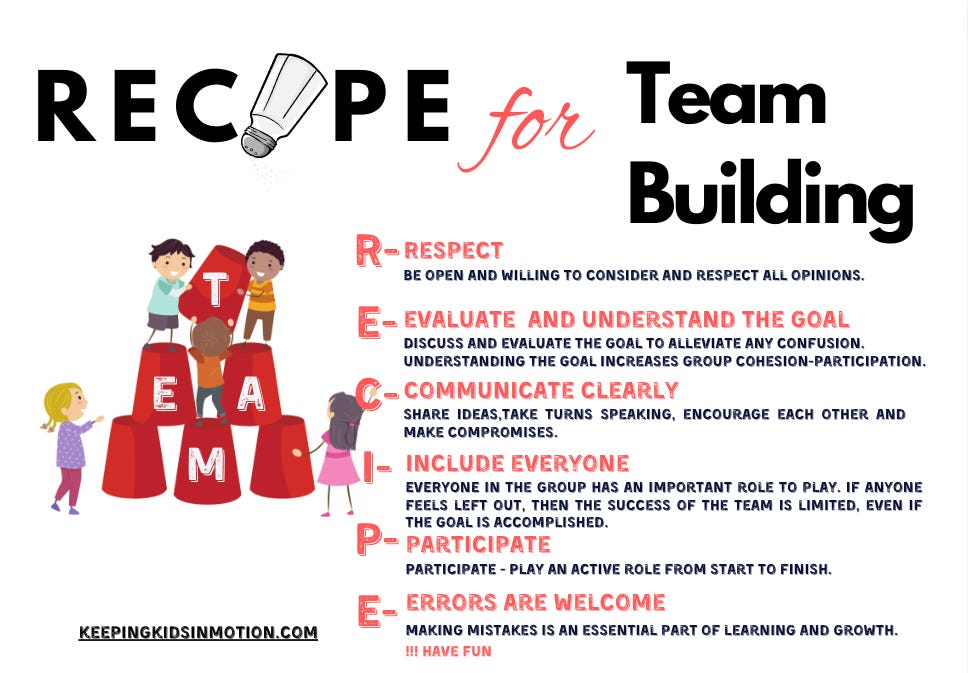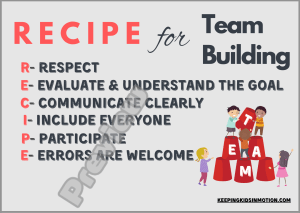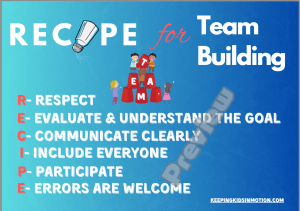No matter the age, the skill set for students today should include tools for team building and greater communication skills.
For access to the 12 posters click, RECIPE FOR TEAM BUILDING!
Team building with students improves productivity, boosts motivation, increases collaboration, encourages creativity, and enriches communication.
As in most physical education programs, it has been a tradition for my team and me to kick off the school year with two weeks of team building and cooperative activities. Not only is it the perfect way to get to know students, but it also encourages them to communicate (talk to each other – a dying art!) and problem-solve in small, medium, and large-sized groups. Through these cooperative activities, we are able to determine which students work well in group settings, and those who may have difficulties within this dynamic.
For more on teaching team building, click TEACHING TEAM BUILDING IS AS EASY AS 1, 2, 3…4?
As a reference for me, my team, and of course, our students, we developed THE RECIPE FOR TEAM BUILDING. This recipe consists of six key ingredients we feel are essential to being a positive, contributing team member.
The RECIPE:
1. Respect Your Teammates
An important role for teachers is to create diverse groups. We consistently encourage our students to be willing to work with each and every classmate. This is why we deliberately group students who do not generally work or play together throughout the day. With this approach, repeated reminders regarding respect, patience, and flexibility are paramount.
2. Evaluate and Understand the Goal
In order for a group to be cohesive and for each member to perform at their maximum capacity, the task at hand must be comprehended by all. We encourage our students to have a conversation immediately after a challenge is presented. Along with sharing ideas on how to tackle the challenge, this is the time when each member assures one another that they understand the goal. This alleviates any doubt or confusion, helping the group to run effectively on all cylinders.
3. Communicate Clearly
So much is involved in communicating clearly. This includes sharing ideas, taking turns speaking, encouraging each other, and making compromises. Especially with younger and larger groups, this can be the most challenging ingredient. For many students, their idea is the only idea, therefore neglecting to consider the thoughts of others. Consistent practice and modeling can help strengthen this essential ingredient.
4. Include Everyone
I always tell my students that collaboration is just a fancy word for working together nicely and respectfully. It’s also important for them to realize that collaboration means that EVERYONE in the group has an important role to play. If anyone feels left out, then the success of the team is limited, even if the goal is accomplished. My colleagues and I always celebrate teams that didn’t necessarily complete the goal but cohesively worked together, including everyone throughout the challenge. In our opinion, that is a successful group. More on this coming up.
5. Participate
As mentioned above, each group member needs to feel supported, be heard, and participate in the challenge in order for the group to accomplish complete success. There are times when a student chooses to be silly rather than problem-solve with the group. Often it’s because the student feels left out or maybe still doesn’t understand the plan of attack. When this happens, and the group is unable to encourage this student to return and participate, it’s a good idea for the teacher to step in to provide the tools to do so. In some instances, a private conversation with the student may be necessary. Processing at the end of a challenge is a great time to discuss situations like this.
On other occasions, part of a group or even the whole group can become careless or sloppy when taking on a challenge. This can occur when they begin to rush or turn the challenge into a race. I often preface a challenge by reminding students that success is not defined by who finishes first. Success is defined by the process. Also, as mentioned above, individual students can stray away from the group when they feel left out or ignored. When all members are locked into the challenge success is almost always guaranteed.
6. Errors are welcome, make mistakes!
This ingredient can seem unnecessary, similar to that pinch of salt you add to a banana bread recipe. Most students will tell you that making mistakes is essential for learning. If at first, you don’t succeed, do you give up and continue the same process, or do you regroup, go back to the drawing board, and try again? Some of my most successful groups are the ones who fail over and over and over again. What makes them special is their fortitude and resilience, their ability the pick themselves up and try again.







